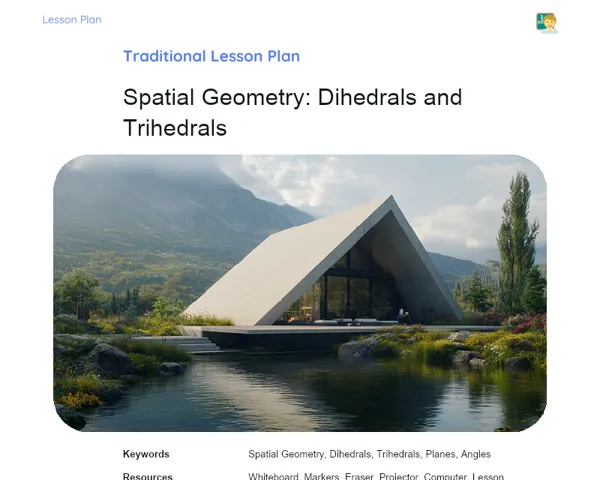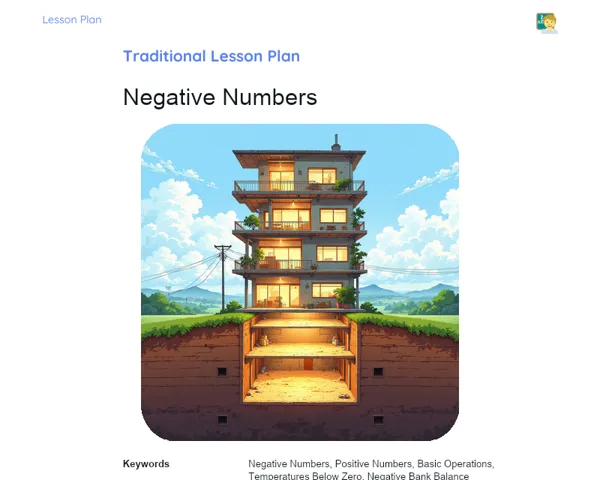Lesson Plan | Lesson Plan Tradisional | Probability of Complementary Events
| Keywords | Probability, Complementary Events, Sum of Probabilities, Coin Toss, Practical Examples, Problem Solving, 8th Grade Mathematics, Fundamental Concepts, Practical Application |
| Resources | Whiteboard and markers, Projector and computer for slide presentations, Slides with theory and probability examples, Coins for demonstration of coin tosses, Dice for practical examples, Notebooks and pens for student notes, Worksheets for problem-solving activities |
Objectives
Duration: (10 - 15 minutes)
The aim of this stage is to give students a solid grasp of the essential concepts surrounding complementary events and their probabilities. This involves being able to calculate both the probability of an event and its complement, as well as understanding that the total probabilities add up to 1. This sets students up to tackle practical problems involving probability, solidifying theoretical knowledge with hands-on examples.
Objectives Utama:
1. Understand and calculate the probability of complementary events.
2. Identify that the total of all potential probabilities of an event equals 1.
3. Utilise the concept of complementary events in real-life scenarios, such as flipping coins.
Introduction
Duration: (10 - 15 minutes)
The aim of this stage is to provide students a clear understanding of the fundamental concepts of complementary events and their probabilities. This includes the ability to calculate the probability of an event and its complement, as well as recognising the sum of the probabilities as 1. This prepares students to solve practical problems involving probability, reinforcing theoretical understanding with concrete examples.
Did you know?
Did you know that probability is commonly used across various fields and in everyday life? For example, weather forecasters rely on it to predict climate patterns, economists use it to evaluate markets, and medical practitioners consider it when assessing treatment effectiveness. Additionally, chance-based games, like roulette and poker, fundamentally hinge on probability concepts, making this area of mathematics relevant and engaging for many common situations.
Contextualization
To kick off the lesson on the probability of complementary events, explain to the learners that probability is a mathematical method to gauge the likelihood of an event occurring. Everyday examples can illustrate this concept, like the chance of rain on any given day, the odds of winning the lottery, or the probability of rolling a certain number on a die. Stress that probability is represented as a figure between 0 and 1, where 0 signifies that the event can't happen and 1 means it will definitely happen. Introduce complementary events, clarifying that they encompass all possible outcomes. For instance, when flipping a coin, the 'heads' outcome and the 'tails' outcome are complementary, as at least one of these will always occur.
Concepts
Duration: (50 - 60 minutes)
The purpose of this stage is to deepen students’ understanding of the probability of complementary events through practical examples and questions to solve. This reinforces previously explained theory and allows students to apply their acquired concepts effectively.
Relevant Topics
1. Definition of Probability: Define probability as a measurement of the likelihood of an event occurring, which ranges from 0 to 1. Use relatable examples such as the chance of rain or rolling a certain number on a die.
2. Complementary Events: Define complementary events as those that encompass all outcomes of an experiment. For example, in a coin toss, 'heads' and 'tails' are complementary outcomes, as they cover all possibilities.
3. Sum of Probabilities: Emphasise that the combined probability of all complementary events always equals 1. This means if P(A) is the probability of event A happening, then P(not A) is the probability of event A not happening, with P(A) + P(not A) = 1.
4. Practical Examples: Present real-world examples for calculating the probability of complementary events, such as finding the likelihood of not rolling heads when tossing a coin three times. Explain the calculation steps and logic behind it thoroughly.
To Reinforce Learning
1. If the likelihood of rain tomorrow is 0.3, what's the probability of no rain?
2. What’s the probability of not rolling a 5 on a standard die (which has 6 faces)?
3. When flipping a coin three times, what’s the probability of not getting heads at all?
Feedback
Duration: (25 - 30 minutes)
The purpose of this stage is to review and discuss answers to the proposed questions, ensuring that students fully grasp the concepts of probability of complementary events. It also aims to stimulate deeper reflection among students concerning the real-life applications of these concepts, fostering a more meaningful and lasting learning experience.
Diskusi Concepts
1. If the likelihood of rain tomorrow is 0.3, what’s the probability of no rain? Explain that the sum of probabilities of all possible events is equal to 1. So, if rain has a probability of 0.3, no rain will be 1 - 0.3 = 0.7. 2. What’s the likelihood of not rolling a 5 on a standard 6-sided die? Mention that the chance of rolling any given number on a 6-sided die is 1/6. Thus, the chance of not rolling a 5 is 1 - 1/6 = 5/6. 3. When tossing a coin three times, what’s the probability of not getting heads at all? Here, the chance of not getting heads in one toss is 0.5 (as there are two options: heads or tails). In three tosses, the likelihood of avoiding heads altogether is (0.5) x (0.5) x (0.5) = 0.125.
Engaging Students
1. What are other day-to-day situations where we can use the idea of complementary events? 2. How does understanding probability help us in making everyday decisions? 3. If we roll a die twice, what’s the probability of not rolling any even number? 4. How would you describe the concept of complementary events to a classmate in your own words?
Conclusion
Duration: (10 - 15 minutes)
The aim here is to summarise and recap the key points covered in the lesson to solidify students' learning. Moreover, the conclusion ties theory to practice and highlights the significance of the topic, ensuring that students recognise the relevance and application of the concepts they've learned.
Summary
['Probability measures the chance of an event happening and ranges from 0 to 1.', 'Complementary events are those that together encompass all outcomes of an experiment.', 'The total of the probabilities of all complementary events is always equal to 1.', 'To find the probability of a complementary event, subtract the probability of the main event from 1.', 'Practical examples were discussed, like the probability of not getting heads when flipping a coin three times.']
Connection
The lesson linked the theory of probability of complementary events with practice through clear and detailed examples, such as coin tosses and dice. This allowed students to see how theoretical concepts apply in real situations and how mathematics can help tackle everyday problems.
Theme Relevance
Understanding the probability of complementary events is crucial not just for mathematics but also for various fields and everyday contexts. For instance, weather predictions, gambling, and even healthcare decisions rely on these concepts. Knowing how to compute probabilities empowers learners to make informed decisions and gain a better understanding of their surroundings.


